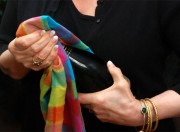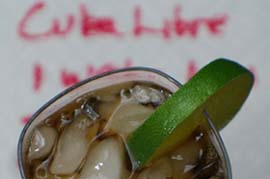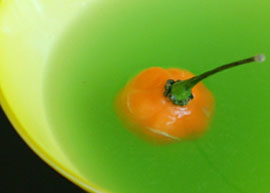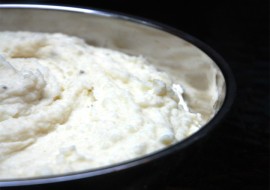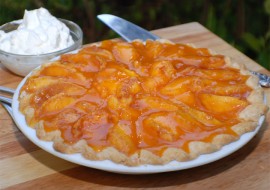In the early 1970’s, Marcella Hazan was busy working on The Classic Italian Cook Book—her first of six books that would change the way Americans view and cook Italian cuisine. Across the country in my tiny San Francisco kitchen, I was perfecting an awesome version of spaghetti and meatballs. Unlike my friends who poured canned tomato sauce on overcooked pasta, or worse yet, opened a can of Spaghetti-O’s, I sautéed onions and garlic with ground beef, added dried herbs, a little wine and canned tomato sauce. Who knew my proud creation bore little resemblance to the classic sauces and pasta of Hazan’s world? Life was about to change.
Decades later I, along with millions of American and international home chefs, have learned the cooking techniques and classic recipes of Italy through Hazan’s books. Others more fortunate have attended her popular cooking schools in New York, Bologna and Venice.
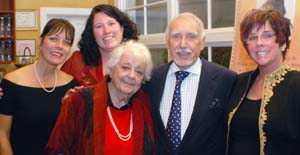
Earlier this week, Hazan came to town for the Cooks with Books dinner celebrating her life and latest book, Amarcord: Marcella Remembers. Fans packed the Left Bank restaurant to meet and share a meal with the woman they know as the godmother of Italian cuisine—a woman knighted in Italy and the recipient of two Lifetime Achievement awards from the James Beard Foundation and the IACP.
I arrived early, but started socializing and ended up at the back of the check-in line. As it turned out, the long wait was a great chance to learn a bit more about the star of the evening. One lady mentioned that Hazan had survived World War II and a series of terrifying air-raids with her family on an Italian farm. Another guest added that Hazan has two PhD’s in science. I knew that that Hazan had married Victor, love of her life, greatest supporter and writing collaborator, 53 years ago. Personally, I hoped that he’d be there as I’m a sucker for a good love story.
Some might say we owe a debt of gratitude to Victor for all that Marcella has given us. A native New Yorker and accomplished food and wine expert in his own right, Victor moved his bride to the city in 1955. Marcella did not speak English and found herself in a completely alien world with no friends or family. She couldn’t work in her field, and worst of all did not know how to cook. What to do? Victor gave her his favorite Italian cookbook, Ada Boni, with lots of encouragement. Before long she was teaching classic Italian cooking in her small apartment.
Somebody poked me excitedly and said, “Look!” There sat Marcella Hazan, now 84, dressed in red with her snow-white hair glowing under the lights. The CWB staff had seated her comfortably with Victor standing at her side. She greeted her fans in a low, husky, accented voice, smiled easily and signed their books.
Hazan’s assistant told me that she was a little tired, having been on this grueling book tour for three weeks. Others observed that Marcella and Victor had a great sense of humor and took good care of each other. Both are still passionate about food and constantly talk about where to eat out next as they travel.
The Cooks with Books dinners are always prepared from the author’s book, but Amarcord is a memoire with no recipes. Therefore the chef chose a menu from Hazan’s earlier work, Marcella Says…
Amuse Bouche
Avocado and Parmesan Crostini
Sweet Pickled Onions
First Course
Mushroom and Potato Soup with Sundried Tomatoes
Entrée
Lamb Chops Calabria Style with Tomatoes, Peppers and Olives
Dessert
Apple Cake with Raisins and Rum
As guests enjoyed their dessert, Hazan took the microphone for a question and answer session. When someone yelled out, “Do you still cook every day?” Hazan replied coolly, “Do you eat everyday? Of course I cook.” The crowd roared.
When a woman in the back asked about salt, I was reminded of a fascinating passage in Amarcord, where Hazan relates how precious salt was to her family during the war years when it was almost unobtainable. Luckily, her uncle worked for the local electric company and did not have to pay for his home supply. His clever wife plugged in a small electric heater and constantly boiled seawater from their nearby lagoon until only salt remained. Carefully she gathered and packaged her treasure and shared it with her sister’s family. They kept some, and used the remainder to barter for honey and fresh milk from their neighbors. In the context of such stories, one finds new appreciation for the value of even the most humble ingredients.
The evening hit a high note when a group of Hazan’s former students gathered to share old photos and mementos. Hazan’s emotion was apparent as her students expressed how profoundly she had touched their lives.
Indeed, all of us have richer culinary lives because of the love and passion for Italian cuisine that Hazan has shared for decades. She is a legend of enormous talent, but also someone we can all relate to. After all, like most of us, she started out in the kitchen with nothing more than a cookbook and the love and encouragement of family.
Cheers and long life to Marcella and Victor!
Get a printable copy of Marcella Hazen’s Apple Cake with Raisins and Rum.




